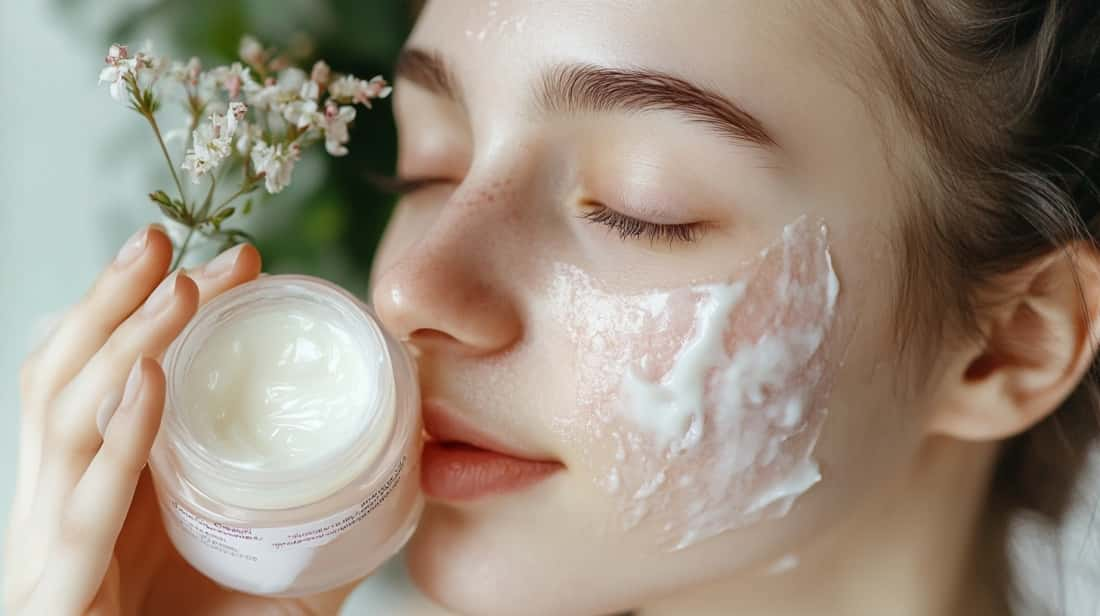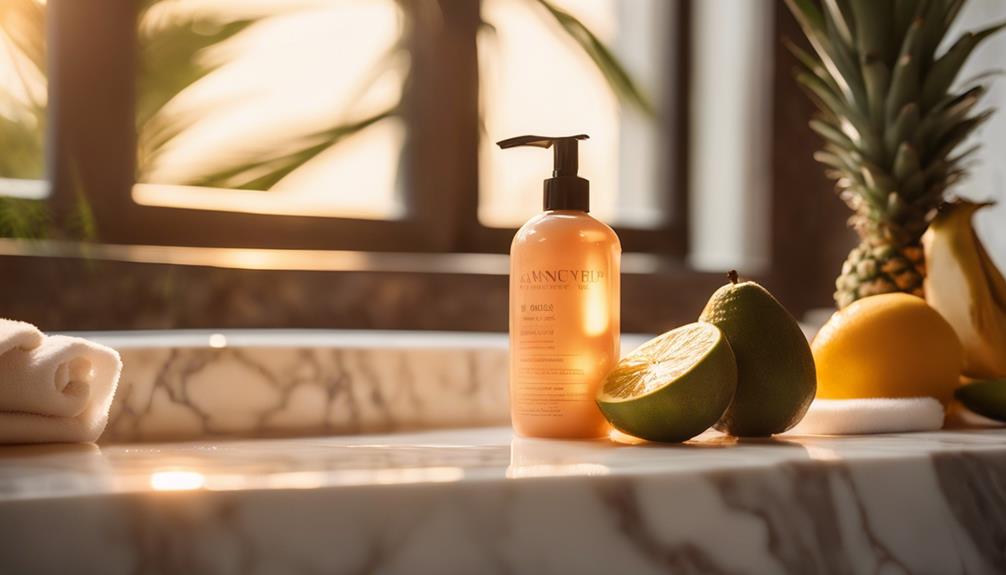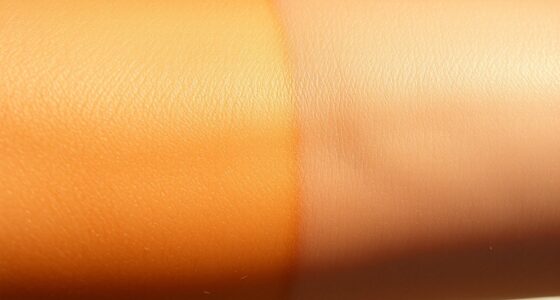Glycolic acid transforms your skin by enhancing cell turnover and promoting a smoother, clearer complexion. It acts as a chemical exfoliator, breaking down bonds between dead skin cells, which leads to fewer dark spots and reduced fine lines. You’ll also notice clogged pores unclogging, decreasing breakouts. For best results, start with a gentle, low concentration and gradually increase use based on tolerance. Always apply in the evening and follow up with a moisturizer. To guarantee safety and effectiveness, consider hydration and sun protection. There’s much more to discover about incorporating it into your routine for maximum benefits!
Key Takeaways
- Glycolic acid enhances cell turnover, resulting in smoother, brighter skin and improved texture over time.
- It effectively fades dark spots and hyperpigmentation, promoting an even skin tone.
- Regular use diminishes fine lines and wrinkles, contributing to a youthful appearance.
- Glycolic acid unclogs pores, reducing the likelihood of acne breakouts and improving skin clarity.
What Is Glycolic Acid?
Glycolic acid, a powerful alpha-hydroxy acid derived from sugar cane, is renowned for its ability to exfoliate and improve your skin’s texture. Its small molecular structure allows it to penetrate deeply into the skin, making it one of the most effective AHAs available.
By functioning as a chemical exfoliator, glycolic acid dissolves the bonds between dead skin cells, promoting a smoother complexion and enhancing cell turnover. The benefits of chemical exfoliation, similar to those seen in aromatherapy techniques, can lead to improved overall skin health.

You’ll find glycolic acid featured in various skincare products, such as cleansers, toners, and serums, each designed to address different skin concerns. Its exfoliating properties help in sloughing off those unwanted dead skin cells, revealing a healthier layer beneath.
This process not only improves skin texture but can also lead to a more even skin tone, as it aids in fading dark spots and reducing the appearance of wrinkles.
Incorporating glycolic acid into your routine can greatly impact your skincare journey, making it a go-to ingredient for anyone looking to achieve radiant skin.
With regular use, you’ll notice how this acid transforms your complexion, making it smoother and more vibrant.
Benefits of Glycolic Acid
Glycolic acid offers impressive benefits for your skin, primarily through its exfoliating and cell renewal properties.
By promoting cell turnover, it helps you achieve a smoother texture and brighter complexion.
Incorporating gentle practices, like yoga for back pain management, can further enhance your overall skin health by reducing stress and tension.

Additionally, it effectively reduces dark spots, giving you a more even skin tone and clearer appearance.
Exfoliation and Cell Renewal
Accelerating exfoliation and boosting cell renewal, glycolic acid plays an essential role in achieving smoother, brighter skin. This powerful alpha-hydroxy acid works by exfoliating the top layers of your skin, effectively dissolving the bonds between dead skin cells. As a result, you’ll notice an improved skin texture and tone, leaving your complexion looking fresh and revitalized.
Incorporating essential oils for skin health can additionally enhance your skincare routine, providing additional benefits such as hydration and anti-inflammatory effects.
Regular use of glycolic acid considerably enhances cell turnover, which means your skin sheds its old cells and produces new ones more efficiently. This process not only helps diminish fine lines and wrinkles but also promotes a more youthful appearance over time.

Moreover, by preventing the buildup of dead skin cells, glycolic acid unclogs pores, reducing the likelihood of acne breakouts.
As you incorporate glycolic acid into your skincare routine, you’ll also see improvements in overall skin clarity, making it suitable for various skin types. With consistent application, you’ll uncover a brighter complexion, paving the way for healthier skin that radiates confidence.
Embrace glycolic acid’s transformative power and enjoy the benefits of smoother, rejuvenated skin.
Dark Spot Reduction
Reducing dark spots and hyperpigmentation becomes more achievable with glycolic acid, thanks to its ability to promote cell turnover and exfoliate the skin’s outer layer.
Incorporating holistic lifestyle approaches, which include stress management techniques, can further enhance the skin’s response to treatments.
When you incorporate glycolic acid into your skincare routine, you’ll notice a gradual fading of dark spots over time. This is possible because glycolic acid effectively breaks down the bonds between dead skin cells, allowing fresh, even skin to emerge.

Clinical studies show that using glycolic acid at concentrations around 5% can considerably enhance your skin tone while diminishing the appearance of hyperpigmentation.
The small molecular size of glycolic acid enables it to penetrate deep into your skin, maximizing its effectiveness.
Additionally, by stimulating collagen production, glycolic acid not only tackles existing dark spots but also improves overall skin texture. This leads to a smoother, more even skin appearance.
Regular use of glycolic acid helps prevent the formation of new dark spots, maintaining a clearer complexion.
How to Use Glycolic Acid
When you’re ready to use glycolic acid, start with a gentle, low-concentration product to help your skin adjust.
It’s important to take into account your overall skin health during this process, especially if you’re experiencing changes like increased sensitivity or dryness, which can be common during pregnancy.
Applying it in the evening after cleansing, and make sure to follow up with a moisturizer.
Remember, consistency is key, so gradually increase usage as your skin tolerates it.
Managing Daily Headaches During Pregnancy’s Second Trimester can provide insights on maintaining overall wellness while incorporating new skincare routines.
Best Application Practices
To get the most out of glycolic acid, start with a low concentration product and apply a pea-sized amount to clean, dry skin. This helps minimize irritation and allows your skin to adjust.

Gradually increase the frequency of application from once a week to three times weekly, allowing rest days in between to prevent over-exfoliation and manage skin sensitivity.
Before diving in, always conduct a patch test, especially if you have sensitive or reactive skin. This quick test can help you gauge how your skin reacts to glycolic acid and avoid potential allergic reactions.
After applying glycolic acid, follow up with a hydrating moisturizer. This not only replenishes moisture but also supports your skin barrier, which is essential after exfoliation.
Incorporating Into Routine
Incorporating glycolic acid into your skincare routine can elevate your complexion, providing smoother and brighter skin with regular use. The gentle exfoliation provided by glycolic acid helps to remove dead skin cells, reducing the appearance of fine lines and wrinkles. In addition, glycolic acid can also help to improve the skin’s overall texture and tone, making it an excellent choice for those struggling with uneven pigmentation or dullness. Overall, the benefits of glycolic acid for skin make it a valuable addition to any skincare routine, providing noticeable improvements over time.
Start with a low-concentration glycolic acid product, around 5% to 6%, applying it once a week. This allows your skin to adjust before you gradually increase usage up to three times a week. Make certain to cleanse your face thoroughly before application to guarantee maximum penetration and benefits.
After applying glycolic acid, follow up with a hydrating moisturizer to replenish moisture and reduce any potential irritation from exfoliating the top layer of your skin.
It’s essential to be mindful of skin sensitivity; using glycolic acid can make your skin more reactive. As a result, avoid combining it with other potent actives like retinol or salicylic acid on the same days to minimize irritation.
Lastly, always apply sunscreen with SPF 50 or higher daily. Glycolic acid increases your skin’s sensitivity to sun exposure, making it vital to protect your skin from potential damage.
Side Effects and Precautions
Glycolic acid can cause irritation, redness, and dryness, especially for those with sensitive skin, so starting with lower concentrations is wise to minimize discomfort. High concentrations (above 10%) can lead to severe side effects like burns or scarring. If you have darker skin tones, be cautious; overusing glycolic acid may increase the risk of hyperpigmentation.

To protect your skin, always apply sunscreen with SPF 50 or higher when using glycolic acid. This product heightens skin sensitivity to UV rays, increasing the likelihood of sun damage. Additionally, avoid combining glycolic acid with other potent exfoliants or active ingredients like retinol or salicylic acid, as this can lead to compounded irritation.
Here’s a quick summary of potential side effects and precautions:
| Side Effect | Description | Precaution |
|---|---|---|
| Irritation | Redness, dryness, or peeling | Start with lower concentrations |
| Hyperpigmentation | Darkening of skin in some individuals | Monitor skin response |
| Sun Sensitivity | Increased risk of sun damage | Use daily sunscreen (SPF 50 or higher) |
Key Ingredients in Glycolic Acid Cream
Many glycolic acid creams feature a blend of key ingredients that enhance their exfoliating and hydrating properties.
At the heart of these formulations is glycolic acid, a powerful alpha-hydroxy acid (AHA) known for its small molecular size, allowing for deep skin penetration and effective exfoliation. This ingredient works to slough away dead skin cells, revealing a brighter complexion.
To combat the potential drying effects of exfoliation, many creams incorporate hydrating ingredients like glycerin and hyaluronic acid. These ingredients help retain moisture, ensuring your skin stays plump and hydrated.
Additionally, soothing agents such as aloe vera are included to minimize irritation and provide a calming effect, which is vital for those concerned about skin sensitivity.
Furthermore, antioxidants like Vitamin C may be present in glycolic acid formulations to protect your skin from free radicals and promote overall skin health.
Some products even mix in additional AHAs, like lactic acid or mandelic acid, to enhance efficacy while being gentler on sensitive skin.
With this combination of ingredients, glycolic acid creams offer a thorough approach to skincare.

Recommended Glycolic Acid Products
Discover some of the top glycolic acid products that can elevate your skincare routine and promote a radiant complexion.
If you’re looking for gentle exfoliation, SkinCeuticals Glycolic 10 Renew Overnight is an award-winning cream that hydrates while you sleep, making it perfect for daily use.
For an affordable option, check out L’Oréal Paris Revitalift Triple Power 10% Pure Glycolic Acid Serum. This serum combines 10% glycolic acid with aloe juice, offering effective skin renewal and hydration.
If you’re new to glycolic acid, Naturium Glycolic Acid Resurfacing Solution 8% is a gentle choice that includes hydrating ingredients and comes at a budget-friendly price of $20.
For those seeking more thorough exfoliation, Drunk Elephant TLC Framboos Glycolic Night Serum blends AHA and BHA for excellent results, though it’s on the higher end at $90.
Combining Glycolic Acid With Other Ingredients
Combining glycolic acid with other ingredients can enhance your skincare routine, but it’s crucial to choose compatible products to avoid irritation.
Using glycolic acid as a chemical exfoliant alongside certain ingredients can lead to increased skin sensitivity. For instance, avoid pairing it with retinol or salicylic acid, as this combination can cause over-exfoliation and potential skin damage.
If you’re considering adding vitamin C to your regimen, it’s best to use it at different times of the day—apply vitamin C in the morning and glycolic acid at night. This approach minimizes the risk of skin irritation and allows both ingredients to work effectively.
To help balance the effects of glycolic acid, consider incorporating soothing agents like aloe vera or hyaluronic acid. These ingredients can provide additional hydration and comfort to your skin, counteracting the potential dryness that glycolic acid may cause.
Be cautious with other brightening agents, like hydroquinone, as mixing it with glycolic acid can heighten skin irritation. Instead, opt for gentler alternatives to achieve your desired results without compromising skin health.
Community Engagement and Skincare Tips
Engaging with others in skincare discussions can enhance your understanding of glycolic acid and its benefits for your skin. By participating in community forums or social media groups, you can gather valuable insights and shared experiences related to glycolic acid products.
Many users report improvements in skin clarity and hydration when they consistently incorporate these products into their routines. You’ll find that community engagement often leads to discovering practical tips and tricks for applying glycolic acid effectively.
Members frequently share humorous anecdotes about their nighttime skincare rituals, making the sometimes awkward process more relatable. This camaraderie can motivate you to stick with your routine, knowing you’re not alone in the journey.
When you hear positive feedback from others, it reinforces the importance of gradually introducing glycolic acid into your regimen. Remember, consistency and patience are essential for achieving the vibrant, youthful skin you desire.
Conclusion
Incorporating glycolic acid into your skincare routine can be a game-changer for your complexion. With its ability to exfoliate and rejuvenate, it’s like giving your skin a fresh start.
However, always remember to proceed with caution—your skin deserves gentle care.
So, why not initiate this transformative journey? Embrace the glow and let glycolic acid expose the radiant skin you’ve always wanted.
After all, isn’t it time to disclose your true beauty?









